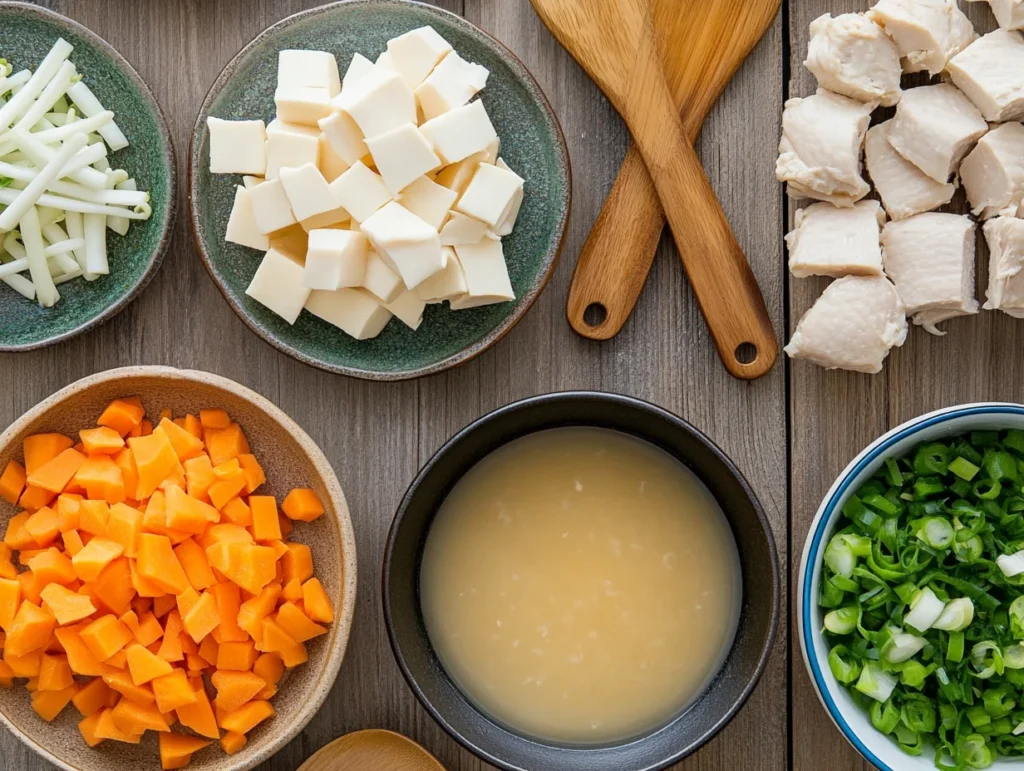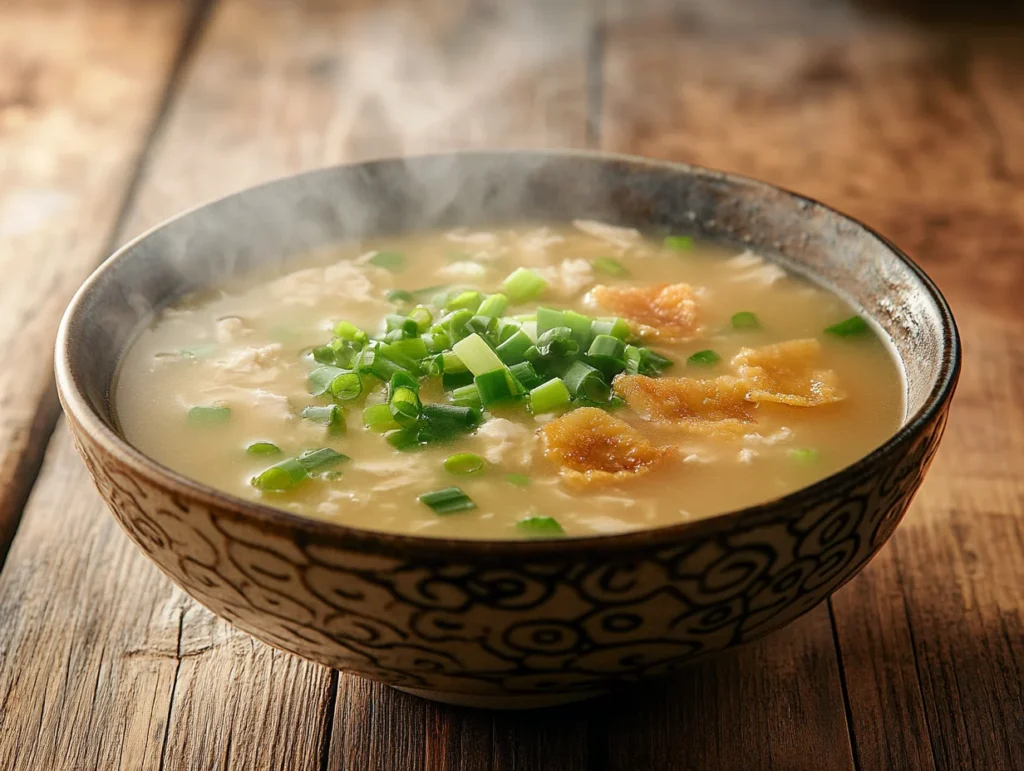Chicken miso soup is more than just a comforting bowl of warmth—it’s a culinary treasure that blends rich umami flavors with nourishing ingredients. In this guide, we’ll explore everything you need to know about this delicious soup, from its cultural roots to step-by-step preparation techniques. Whether you’re a seasoned home cook or a kitchen novice, you’ll find useful tips, variations, and FAQs to perfect your own chicken miso soup.
Let’s kick things off by understanding what makes this dish so special and its cultural significance in Japanese cuisine.
Introduction
What is Chicken Miso Soup?
At its core, chicken miso soup combines tender chicken pieces, a variety of fresh vegetables, and miso paste to create a bowl of deeply satisfying warmth. Unlike the more common tonjiru (pork miso soup), this version swaps pork for chicken, giving it a lighter yet equally rich taste.
Miso paste, made from fermented soybeans, is the heart and soul of this dish, infusing every spoonful with its signature savory umami flavor. Meanwhile, chicken not only enhances the protein content but also adds a hearty depth to the broth.
While many miso soup recipes stick to tofu and seaweed, chicken miso soup elevates the experience with its balanced texture and wholesome ingredients.
From a quick weeknight dinner to a comforting remedy on a cold day, this soup is as versatile as it is delicious.
The Origins and Cultural Significance
Chicken miso soup, or Torijiru in Japanese, isn’t as widely known as its pork-based cousin, tonjiru, but it holds its own charm and legacy. The soup originated as a hearty, rustic dish enjoyed in colder regions of Japan, where its rich broth provided warmth and nutrition during harsh winters.
Historically, miso soup itself has been a staple in Japanese households for centuries. Miso paste was once considered a luxury ingredient, enjoyed by nobility and monks before it became widely accessible to the general population. As chicken farming became more common, it naturally found its way into this traditional broth.
In modern Japan, chicken miso soup is cherished for its homey appeal and adaptability. It’s not bound by strict recipes—families often add their favorite vegetables or regional ingredients, making each version unique.
Today, this dish continues to bridge generations, offering not only nourishment but also a connection to Japanese culinary tradition.
Key Ingredients
Essential Ingredients: Chicken, Miso, and Vegetables
The beauty of chicken miso soup lies in its simplicity and the depth of flavor achieved with a handful of core ingredients. At the heart of this dish is miso paste, a fermented soybean condiment that brings umami richness. Yellow miso (awase miso) is often the top choice for its balanced taste, but red miso (akamiso) can also add a deeper, bolder flavor.
Equally important is the chicken. While chicken thighs are preferred for their tender texture and rich flavor, chicken breast can work well too. The key is to keep the skin on during cooking to enhance the broth’s richness.
Vegetables such as daikon radish, carrots, burdock root, and enoki mushrooms contribute sweetness and texture to the soup. Additionally, aromatics like garlic and ginger elevate the flavor profile while sesame oil adds a subtle nuttiness.
For the soup base, traditional Japanese dashi broth is essential. If you can’t find dashi, a homemade chicken stock can serve as a decent substitute.
For more ideas on using vegetables in soups, you can explore Creamy Potato Soup Recipe for additional inspiration.
Understanding Different Types of Miso Paste
Not all miso paste is created equal. In chicken miso soup, choosing the right miso can make a significant difference in flavor.
- Yellow Miso (Awase Miso): Balanced flavor, slightly sweet, and perfect for beginners.
- White Miso (Shiro Miso): Mild and slightly sweet, ideal for a lighter soup base.
- Red Miso (Akamiso): Bold and salty, excellent for adding robust depth.
If you’re experimenting with different miso types, start with yellow miso for its adaptability. For more detailed insights into miso, check out Miso Soup Calories for nutritional details.
Ingredient Substitutions and Alternatives
Can’t find all the ingredients for chicken miso soup? Don’t worry—you can make substitutions without losing the essence of the dish:
- Chicken: Substitute with turkey or pork for a different twist.
- Vegetables: Use shiitake mushrooms, napa cabbage, or even potatoes.
- Dashi Broth: Replace with chicken stock or vegetable broth if needed.
These substitutions ensure you can still enjoy the delightful warmth of chicken miso soup without compromising too much on taste.
How to Make Chicken Miso Soup: Step-by-Step Guide

Preparing Vegetables and Chicken
Before you start cooking, preparation is key. Chop all your vegetables—carrots, daikon radish, burdock root, and mushrooms—into bite-sized pieces. Mince the garlic and ginger finely for maximum aroma.
For the chicken, remove the skin carefully (but keep it aside for rendering later) and cut the meat into small, even chunks.
Pro tip: Use a sharp knife to make chopping vegetables easier and quicker.
Cooking the Soup Base
Start by heating a tablespoon of sesame oil in a large pot. Add the reserved chicken skin and cook it until crispy to release the flavorful chicken fat. Remove the crispy skin and set it aside for garnishing later.
In the same pot, add the chicken pieces and sauté until golden brown. Follow up with minced garlic and ginger, allowing their fragrance to infuse the oil.
Add your chopped vegetables and stir-fry them for a few minutes to build layers of flavor. Pour in the dashi broth (or chicken stock) and bring the soup to a gentle simmer.
Adding Miso Paste the Right Way
Once the vegetables are tender, it’s time to add the miso paste. Never add miso directly into boiling water—it can destroy its delicate flavors.
Instead:
- Place the miso paste in a fine mesh strainer or ladle.
- Dip it into the broth and stir gently until the paste dissolves evenly.
This method ensures your chicken miso soup remains smooth and well-blended.
For another miso-based recipe idea, check out Mushroom Miso Soup.
Your soup is now ready to serve! Ladle it into bowls, garnish with chopped green onions, and add the crispy chicken skin for a delightful crunch.
Variations of Chicken Miso Soup
Regional Variations of Chicken Miso Soup
Just like many traditional dishes, chicken miso soup has evolved across regions, each adding a unique twist to suit local tastes and available ingredients. In northern Japan, you’ll often find versions with heartier root vegetables, perfect for cold winters. In contrast, southern regions might incorporate lighter greens like mizuna or add citrus zest for a refreshing touch.
In some rural areas, the soup is enriched with kabocha squash or sweet potatoes, lending it a subtle sweetness. Meanwhile, coastal towns might add a touch of seafood, such as shrimp or small clams, transforming the classic broth into a fusion of land and sea flavors.
These regional touches remind us that chicken miso soup isn’t just a dish—it’s a reflection of culture and geography, adapted to tell a flavorful story from every corner of Japan.
For more inspiration on unique regional soup styles, you might enjoy reading about Creamy Potato Soup Recipe.
Adapting the Recipe for Dietary Preferences
The flexibility of chicken miso soup makes it a perfect dish for various dietary preferences and restrictions. Here are some easy adaptations:
- Gluten-Free: Use gluten-free soy sauce and ensure your miso paste is labeled gluten-free.
- Vegetarian Version: Swap chicken for tofu and use vegetable broth instead of dashi stock.
- Low-Sodium Diet: Opt for low-sodium miso paste and reduce the added soy sauce.
If you’re feeling creative, you can also add quinoa or brown rice to make the soup more filling.
Whether you’re customizing for health reasons or simply experimenting with flavors, chicken miso soup can be tailored to suit almost any dietary need.
For another delicious soup recipe, consider checking out Mushroom Miso Soup.
Tips for Perfect Chicken Miso Soup

Balancing Flavors in Chicken Miso Soup
Perfecting the balance of flavors in chicken miso soup can make all the difference. The key is achieving harmony between the savory miso paste, the richness of chicken, and the sweetness of the vegetables.
- Don’t Overcook the Miso Paste: Always add miso paste after turning off the heat to preserve its delicate flavor and nutrients.
- Taste as You Go: Adjust the amount of miso paste gradually—different brands can vary in saltiness.
- Layer Your Ingredients: Start with aromatics like garlic and ginger, followed by chicken, then root vegetables, and finally leafy greens.
Using these steps ensures that every spoonful is packed with balanced flavors, satisfying both your taste buds and your soul.
Common Mistakes and How to Avoid Them
Even experienced cooks can stumble when preparing chicken miso soup. Here are some common pitfalls and how to sidestep them:
- Boiling the Broth After Adding Miso: High heat can cause miso paste to lose its signature flavor and turn bitter. Always add it off-heat.
- Skipping the Chicken Skin Step: Chicken skin, when crisped and rendered, adds an unbeatable richness to the broth. Don’t skip this step!
- Using the Wrong Miso Paste: Avoid overly salty miso pastes if you’re not familiar with them. Start with yellow miso for a balanced flavor.
These simple yet effective tips will help you prepare a bowl of chicken miso soup that feels restaurant-quality every time.
If you’re looking for another comforting dish, check out Gluten-Free Miso Soup.
Health Benefits of Chicken Miso Soup
Nutritional Value of Chicken Miso Soup
One of the greatest appeals of soup is its balance between rich flavors and nutritional value. This humble soup packs a powerful punch of vitamins, minerals, and essential nutrients that make it both comforting and beneficial for overall health.
Chicken is a great source of high-quality protein, which helps with muscle repair, immune function, and overall body maintenance. Meanwhile, miso paste provides probiotics from its fermentation process, promoting gut health and improving digestion.
The addition of vegetables like carrots, daikon radish, and mushrooms ensures that every spoonful is packed with vitamins A, C, and fiber, which support immune health and digestion.
Even the broth itself, often made from dashi, contains trace minerals and amino acids that contribute to skin health, bone strength, and improved energy levels.
Simply put, every ingredient in chicken miso soup brings something beneficial to the table.
Health Benefits of Miso Paste and Dashi
Miso paste isn’t just about flavor—it’s a nutritional powerhouse. Thanks to its fermentation, miso is loaded with probiotics, which can improve digestion and enhance gut health. It also contains essential amino acids, antioxidants, and B vitamins.
On the other hand, dashi broth—a traditional Japanese soup stock—brings its own benefits. Rich in amino acids like glutamate, it not only enhances the soup’s umami flavor but also supports brain health and energy production.
When combined in chicken miso soup, these two ingredients create a dish that nourishes the body, warms the soul, and supports overall well-being.
Whether you’re fighting off a cold, looking to improve your digestion, or simply craving a healthy meal, chicken miso soup has you covered.
Serving and Presentation Ideas
Traditional Serving Techniques
Presentation plays a huge role in enhancing the enjoyment of chicken miso soup. Traditionally, this soup is served in lacquered bowls, accompanied by chopsticks and a soup spoon.
To achieve an authentic presentation:
- Use Traditional Bowls: Serve in small, deep bowls to keep the soup warm longer.
- Garnish Thoughtfully: Add finely chopped green onions or a sprinkle of sesame seeds just before serving.
- Include a Side Dish: Pair your chicken miso soup with steamed rice or pickled vegetables for a complete meal.
A simple garnish of crispy chicken skin on top adds texture and makes the dish visually appealing.
Pairing Chicken Miso Soup with Other Dishes
While chicken miso soup can shine on its own, pairing it with complementary dishes can elevate the dining experience.
- Steamed White Rice: A classic pairing that balances the rich, savory soup.
- Japanese Pickles (Tsukemono): These tangy sides add brightness and contrast.
- Grilled Fish or Yakitori: A protein-packed companion to the hearty broth.
- Simple Green Salad: Adds freshness to the overall meal.
For a modern twist, try serving the soup with homemade dumplings or even a fresh sushi platter.
These combinations create a well-rounded meal that satisfies both the stomach and the senses.
How to Store and Reheat Chicken Miso Soup
Proper Storage Techniques
Storing chicken miso soup properly is essential to maintain its flavor and freshness. Since miso paste is delicate, it can lose its taste and nutrients if mishandled.
To store your soup:
- Cool it Quickly: Allow the soup to cool to room temperature before storing it.
- Use Airtight Containers: Transfer the soup to airtight glass or plastic containers.
- Separate the Miso Paste: If possible, store the broth and miso paste separately. Add the miso only after reheating for the best flavor.
- Refrigerate Immediately: Place the container in the refrigerator and consume it within 1-2 days.
While freezing is possible. The miso paste and delicate vegetables may lose their texture and taste when thawed.
Best Practices for Reheating Miso Soup
Reheating chicken miso soup requires a gentle approach to preserve its flavors. Boiling the soup can destroy the subtle umami taste of the miso paste.
Follow these steps for reheating:
- Stovetop Method: Pour the soup into a pot and heat it slowly over medium-low heat. Avoid bringing it to a boil.
- Add Fresh Miso (if separated): If you stored the miso separately, whisk it in just before serving.
- Microwave (if needed): Use a microwave-safe bowl, heat in short intervals, and stir between sessions to prevent uneven heating.
Taking care during storage and reheating ensures your chicken miso soup remains just as delicious as when it was freshly prepared.
Part 9: Frequently Asked Questions (FAQs)
Can You Make Miso Soup with Chicken Broth?
Yes, you absolutely can! While traditional miso soup uses dashi stock, substituting it with chicken broth adds a rich, hearty flavor. This variation is perfect if you prefer a more robust soup base or don’t have access to dashi. Just make sure to adjust the salt levels, as chicken broth can already be seasoned.
Does Miso Soup Traditionally Include Chicken Broth?
No, traditional miso soup doesn’t include chicken broth. Instead, it uses dashi, a broth made from kombu (seaweed) and bonito flakes. However, modern variations, such as chicken miso soup, have become popular due to their unique and satisfying flavor profile.
How Do You Make Chicken Miso Soup at Home?
Making the soup at home is simple and rewarding. Start by cooking chicken pieces in sesame oil, add aromatics like garlic and ginger, then pour in dashi stock. Add vegetables, let them simmer, and finish with miso paste for an umami-packed broth. Serve it warm, topped with chopped green onions and crispy chicken skin.
Is Miso Soup with Chicken Healthy?
Absolutely! is packed with protein, vitamins, and probiotics. Chicken provides essential amino acids, while miso paste supports gut health. The added vegetables contribute fiber and antioxidants, making this soup a well-rounded, nutritious meal.
Can You Freeze Chicken Miso Soup?
Technically, you can freeze it, but it’s not recommended. The miso paste can separate, and the vegetables may turn mushy upon reheating. If you need to freeze it, store the broth separately and add fresh miso paste after thawing.




1 thought on “The Ultimate Guide to Chicken Miso Soup: Recipe, Tips, and FAQs”